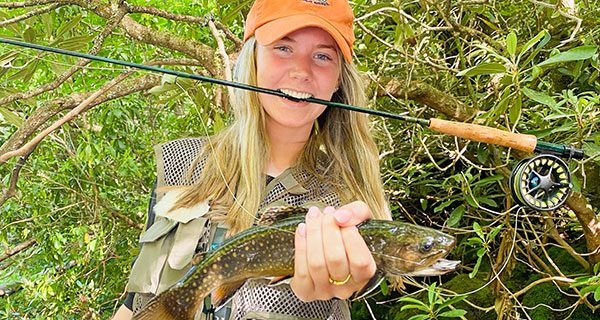To get to the key feature quickly, lets just say that Big Snowbird Creek is one of the best small stream, brook trout streams in North Carolina. It rivals the Raven Fork in Great Smoky Mountains National Park, but many claim it’s the state’s best brook trout stream. Like any other good brook trout stream, the thing that keeps its “good” status is the remoteness of its waters. To get to the best brook trout fishing in Big Snowbird Creek, you are going to have to do a lot of hiking.
Big Snowbird Creek, located near Robbinsville North Carolina, flows into Santeetlah Lake. Its waters are managed by the state, two different ways. It has a wild trout section in its headwaters, and a hatchery supported section in its lower end. The creeks reputation as a good trout stream comes from its wild brook trout territory, which is protected from upstream migrating brown and rainbow trout by three large waterfalls. The creek starts out as a very small brook trout stream on the Snowbird Mountains near the Cherohala Skyway and becomes a rather large brook trout stream in its lower wild trout section that is twenty to thirty five feet wide in places. The three waterfalls are Big Falls, the lowest one; Middle Falls, and Upper Falls.
The best brook trout fishing is above these waterfalls. To get there, you have two options. You can travel to the end of the Big Snowbird Creek Road, which is Forest Service Road #75, to a location known as the Junction and depart by foot up the trail at least six miles to the better brook trout water. You can also hike down the King Meadows Trail from Hooper Bald on the Cherohala Skyway. For those of you who are unfamiliar, the Cherohala Skyway is a twenty-mile long highway that runs along the top of the mountain ridges from Tellico Plains Tennessee to Robbinsville North Carolina. This trail is very steep and it probably takes more effort to reach the better brook trout waters than the lower trail. Once the trail gets to the main brook trout waters, its decline drops drastically and it falls at a much slower pace. There are several small tributary streams that also have populations of brook trout between the lower falls and the middle falls, but you normally will find the largest brook trout in the big pools of the main stream. Brook trout exist up to about 12 inches but most of them probably average about 5 inches.
The lower section is followed by a Forest Service Road (Big Snowbird Road) with not much access. It flows through a mixture of public and private property for its length of eight miles from Santeetlah Lake. The first three miles upstream from the Junction, the Big Snowbird Creek lies far below the trail but can be accessed in places. It has excellent wild brown trout and rainbow trout fishing. There are campgrounds in the upper section and camping is probably the best approach to use to fish the better brook trout waters. Above Sassafras Creek, the stream falls through a series of cascades that are a few hundred feet high. These are known as the Mouse Knob Falls. Above the falls, you will find brook trout only.
The thing that defines Big Snowbird Creek from other streams in this area of the state of North Carolina is its wide streambed. The stream has numerous deep pools, long runs, some short riffles but it’s mostly pocket water with boulders and large rocks spread throughout its waters. There are plenty of Rhododendron that makes for tight situations in the extreme upper parts and all the small tributaries, but you won’t have any casting problems at most any other location on Big Snowbird Creek.
Season: The season runs year-round.
Winter: Trout can be caught most days of the winter.
Spring: Spring is the best time for fly fishing the Linville River due to the hatches.
Summer: Summertime is okay – the water in the gorge stays cool.
Fall: Fall is the best time for big browns in the lower section.
James Marsh is the Owner of The Perfect Fly online and catalog, mail-order store. www.perfectflystore.com
